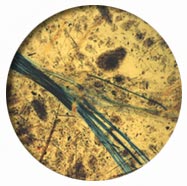PLM (Polarized Light Microscopy) Bulk Sample Analysis

Micro Analytical Laboratories, Inc.'s PLM bulk sample analyses follow the EPA Test Method for Determination of Asbestos in Bulk Building Materials, 1993 (EPA/600/R-93/116). Samples are first examined with a stereobinocular microscope. Representative portions of the sample are mounted on slides with refractive index oils and analyzed with a Polarized Light Microscope (PLM).
If no asbestos is found in a sample, "ND" (None Detected) is reported. If asbestos is found in a sample, two kinds of information are reported in the "asbestos minerals" column of the PLM report. First, the area percentage of asbestos, as determined by visual estimation by PLM. Second, the types of asbestos found are indicated. Additional information about non-asbestos fibers and non-fibrous materials is also recorded.
Many samples consist of distinct materials or layers, which are analyzed separately. Asbestos results from each layer or material are reported individually. Asbestos fibers may be present in some floor tile samples, or other non-friable materials, but may not be detectable by PLM, due to their small size or to the presence of binding materials. The same considerations also apply to dust samples.
Amounts of asbestos below one percent can be detected by routine PLM techniques, but cannot be reliably quantified. An alternative technique, such as quantitative (gravimetric) TEM analysis, is required for such low levels.
If a sample is determined to contain less than ten percent asbestos by visual estimation, the client has the option of requesting confirmation of the asbestos percentage by the PLM point counting technique. Point counting uses larger quantities of sample and systematically analyzes individual particles, whereas visual estimation analyzes fields of view. A minimum of 400 points are counted.
|